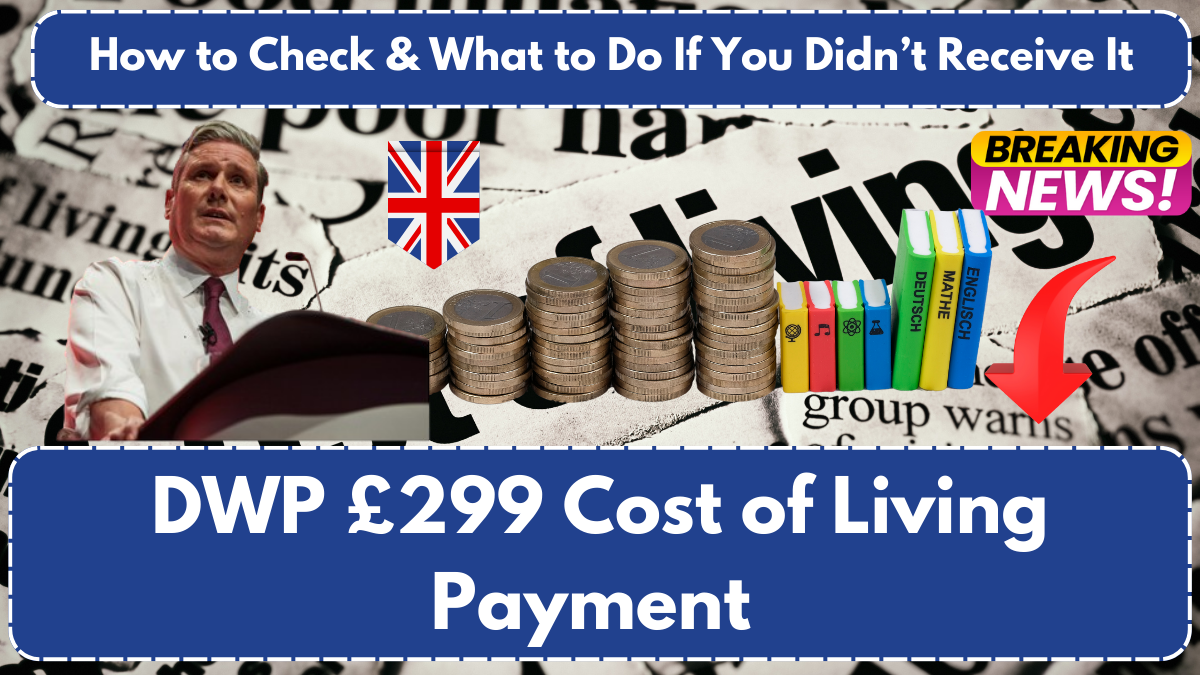As inflation continues to impact UK households, the government has introduced financial support to assist those struggling with rising expenses. The £299 Cost of Living Payment is the third and final installment of a support package aimed at low-income individuals receiving specific benefits. This initiative was designed to provide financial relief amidst increasing energy costs, food prices, and general living expenses.
This guide explains the eligibility criteria, payment process, and what steps to take if you haven’t received your payment.

What Is the £299 Cost of Living Payment?
The £299 payment is the concluding part of the government’s £900 Cost of Living Support package for the 2023–2024 financial year. Previously, two installments of £301 and £300 were distributed, totaling £900 in assistance for qualifying households.
The final payment was issued automatically between 6 February and 22 February 2024, ensuring eligible individuals received direct financial aid. Unlike some government programs, there was no need to apply—if eligible, the payment was processed and deposited directly.
Given the ongoing financial strain caused by high living costs, this support was a crucial relief for many struggling households.
Who Qualified for the £299 Payment?
To receive this payment, individuals had to be receiving at least one of the following means-tested benefits between 13 November and 12 December 2023:
- Universal Credit
- Income-based Jobseeker’s Allowance (JSA)
- Income-related Employment and Support Allowance (ESA)
- Income Support
- Pension Credit
- Working Tax Credit
- Child Tax Credit
As long as there was no break in benefit payments during the qualifying period, recipients were automatically credited with the £299 payment.
Who Was Not Eligible?
Not all benefit recipients were eligible for this payment. Those receiving only the following benefits did not qualify:
- New Style Employment and Support Allowance (ESA)
- Contribution-based ESA
- New Style Jobseeker’s Allowance (JSA)
Since these benefits are not based on income, recipients were excluded from this financial support scheme. Additionally, individuals who had a temporary pause in their benefit claims during the eligibility period may not have received the payment.
How Was the £299 Payment Distributed?
The payment was directly deposited into the bank accounts of eligible recipients. There was no application process, and payments were handled as follows:
- For those receiving benefits from the Department for Work and Pensions (DWP): The payment reference on bank statements appeared as “DWP COL.”
- For those receiving benefits from HM Revenue & Customs (HMRC): The reference appeared as “HMRC COLS.”
Payments were made using the banking details already linked to the recipient’s benefit account.
What to Do If You Didn’t Receive the Payment?
If you expected the payment but did not receive it by 22 February 2024, take the following steps:
- Check your bank transactions – Look for an entry labeled “DWP COL” or “HMRC COLS”.
- Verify your benefit status – Ensure you were receiving a qualifying benefit between 13 November and 12 December 2023.
- Report a missing payment – Visit GOV.UK and fill out the official missing payment form.
- Contact your benefit provider – If you are unsure of your eligibility or need further clarification, reach out to DWP or HMRC for assistance.
Can You Still Get the Payment If You Became Eligible Later?
Some individuals who applied for Pension Credit after the qualifying period may still receive the payment if their claim was backdated. To ensure you receive the payment:
- Submit your Pension Credit application before 5 March 2024.
- Confirm your eligibility with DWP.
- If your claim is backdated to the eligibility period, the payment should be issued automatically. If not, you may need to report it as missing.
Common Reasons for Payment Delays or Issues
Several factors could have delayed or prevented payments. Below are common reasons for issues:
| Issue | Possible Explanation |
|---|---|
| Incorrect Bank Details | Outdated or incorrect account information may have led to payment failure. |
| Benefit Claim Issues | Pending, paused, or denied claims during the eligibility period could result in non-payment. |
| Processing Delays | High transaction volumes may have caused delays in issuing payments. |
| Fraud Prevention Checks | Some payments were temporarily held for security verification. |
If any of these factors apply to you, contact your benefit provider for further assistance.
Read Also: Universal Credit and PIP Overhauls for 2025, DWP Announces Major Updates and Eligibility Criteria
Avoid Cost of Living Payment Scams
Whenever financial aid is provided, scammers attempt to take advantage. Stay vigilant and protect yourself:
- Never share personal or banking details in response to texts, emails, or phone calls claiming to be from DWP or HMRC.
- Ignore messages asking for information—official agencies will never contact you this way.
- Always use GOV.UK for updates and reporting issues.
FAQs About the £299 Cost of Living Payment
1. Do I need to apply for the £299 payment?
No, the payment was automatically issued to those who met the eligibility criteria.
2. What happens if I wasn’t receiving benefits during the eligibility period?
If you applied for Pension Credit late, your claim may be backdated. Contact DWP to check your status.
3. Will there be more Cost of Living Payments in the future?
As of now, the £299 payment was the last installment of the £900 support package. Future assistance depends on government decisions.
4. How do I confirm my eligibility?
Check your benefit statements or contact DWP/HMRC for verification.
5. What should I do if I received the wrong amount?
Report discrepancies through GOV.UK or contact your benefit provider.
By staying informed about the Cost of Living Payment, you can ensure you receive the financial support you’re entitled to and take action if any issues arise.
For More Information Click Here
Akesh is a furniture expert with years of experience in design and craftsmanship. Specializing in sustainable materials, he shares his expertise to help people create stylish and functional living spaces.
